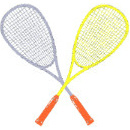

|
There are two ways to approach squash, or indeed any motor skill, like cricket, dancing or driving.
The first way is get the basics right. It can be an approach that demands a little patience, that requires you to unlearn some bad habits before seeing the light.
The second way is to try to win at all costs, using personal quirks and techniques you are better and more comfortable with, than methods that don't seem to be reaping dividends, seem awkward and are difficult to remember.
With the first approach, the sky is your ceiling. With the second, the best you can hope for is to be a fit and energetic loser. The longer you keep up your bad habits, the harder it will be to get it right.
Hold the racket with a slanting hand, and not too tight. In the back of the court, always hold the racket high, so the racket head is level with your own head. In the front of the court, the racket head can drop to chest level.
On the backswing, the wrist should be cocked. On the forehand, this allows scope for powerful wrist action. On the backhand, this encourages a windmill movement, rather than a waist level helicopter action.
Don't let the ball get too close to you - use your feet to make sure you have a comfortable open shouldered swing at every ball.
Your last step before hitting the ball should be a bit of a stretch - you'll hit a better ball this way than if your elbow is cramped at your side because you let the ball get too close to you.
After each shot, try to get back to the T, ready for your opponent's return. Move as cleanly and straight as you can to the ball and back, while keeping out of the way of your opponent's shot.
For any low ball, always have your weight transferred over your leading bent knee at your shot. To volley a higher ball, keep your distance, and don't try to hit it hard.
Keep your racket head in front of your chest at the T, so your racket is ready for a reaction shot.
Vary the strength of your shots. While a lot of top level squash consists of long rallies down the walls, this is just like fighters circling each other before the pounce. Choosing the right time, you should be playing kills, lobs, drops and boasts. These are the attacking shots you need to win.
You must decide which shot you will play before your last step, as your choice dictates where you shoud be standing when the ball is ready for you to hit.
Do not try to belt every ball. The drop and the lob obviously need to be more gentle shots, but a nice length down the wall can be as tricky to return as a power stroke.
In general, choose a shot that sends the ball as far from your opponent as possible. Squash games between evenly matched players are often won by the fittest, so the more you get opponent to run, the better for you.
But you should make sure that opponent can't intercept the ball early, and put you at a disadvantage. So try to play any medium length or long shot so that it is close to the wall when it passes where your opponent is standing. In other words, try to get your shots to the back to hit the wall somewhere around the back of the service box.
The hardest shot is when you have to hit a ball when it is close to the wall. So give this task to your opponent as often as possible.
If you follow the basic principles outlined above there is no reason why you cannot lift your racket to a high backswing as you move off the T, stretching for a power shot, your weight on your leading knee giving you good stability, powering a cross court drive that hits the opposite wall just behind the service box, letting you get back near the T to watch your opponent struggle to make a weak return down the wall. You step forwards and play a dying volley to the front right corner, and your opponent fails to reach it.
Just practice every aspect listed above, and refer to other pages on this site for more details, as you work on each component of your game.
Copyright (C) Richard Hart 2015 - 2018